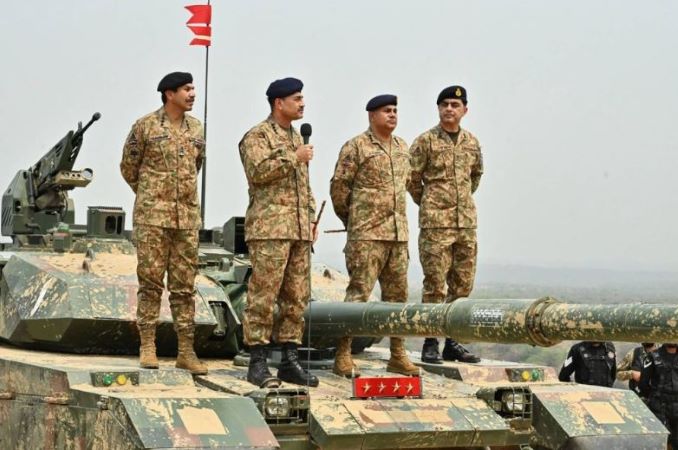Operation Sindoor: A Conditional Ceasefire

By Leo Nirosha Darshan
Geopolitical Analyst
COLOMBO: On May 7, 2025, India launched Operation Sindoor, a decisive military campaign targeting terrorist camps and launch pads across Pakistan and Pakistan-administered Kashmir.
The operation was in direct retaliation for the brutal killing of 26 tourists, including Indian and foreign nationals, in Pahalgam, Jammu and Kashmir, by militants of the Pakistan-based Lashkar-e-Taiba. The attack drew global condemnation and united many countries in their support for India’s right to defend itself against cross-border terrorism.
Symbolically named after “sindoor”—the red mark worn by married Hindu women—Operation Sindoor paid tribute to the wives and families of those killed in the Pahalgam massacre.
The operation was led by two women officers of the Indian Armed Forces, Colonel Sophia Qureshi and Wing Commander Vyomika Singh, highlighting the strength and leadership of women in India’s military response. The campaign struck nine high-value targets, including training centers and logistical hubs in Bahawalpur, Muridke, Sialkot, and Kotli—regions long suspected to harbor militant infrastructure.
One of the most strategically significant strikes was on the Noor Khan Air Base in Chaklala near Rawalpindi, which functions as a major logistical hub for Pakistan’s military. The base hosts C-130 Hercules and IL-78 aerial refueling aircraft and is situated close to the headquarters of the Strategic Planning Division, which oversees Pakistan’s nuclear arsenal. Another critical site, the Mushaf Air Base in Sargodha—connected to underground nuclear storage beneath the Kirana Hills—was also hit in coordinated air raids.
Pakistan’s response included the deployment of Turkish drones and Chinese-supplied missiles. However, these attacks were largely neutralized by India’s multi-layered air defense systems. The Indo-Israeli Akash missile defense system and indigenous L-70 automatic guns successfully intercepted incoming threats. Notably, India’s Russian-made S-400 air defense system was not activated during the confrontation.
On the other side, questions arose regarding the performance of Pakistan’s Chinese HQ-9 air defense system, potentially affecting confidence in Beijing’s military exports.
Operation Sindoor marks a clear escalation in India’s counterterrorism strategy. While India has previously carried out surgical strikes and precision air raids—such as those following the 2016 Uri attack and the 2019 Pulwama bombing—this operation demonstrated a broader reach and strategic intent.
For the first time, targets were struck in Pakistan’s heartland, including Bahawalpur and Muridke in the Punjab province, home to Prime Minister Shehbaz Sharif’s family and known as a Lashkar-e-Taiba stronghold.
Reports indicate that Pakistani military officials were seen attending funerals of the militants killed, with coffins draped in the national flag, underlining the state’s implicit support for these groups.
Following the operation, India and Pakistan agreed to a ceasefire on May 10. However, India immediately announced the suspension of the 1960 Indus Waters Treaty, declaring that it would remain suspended as long as Pakistan continues to sponsor terrorism.
This move represents a decisive shift in India’s strategic posture—one that directly links counterterrorism to water diplomacy, a domain previously kept outside the conflict.

The ceasefire announcement was echoed by U.S. President Donald Trump, who claimed credit for mediating between the two countries. Although India officially denied any third-party involvement, it is evident that Washington played a backchannel role in de-escalating the crisis.
During his first term, Trump had offered to mediate the Kashmir conflict, and now, with renewed global involvement, India may find it increasingly difficult to reject such offers outright. At the same time, India requires global support to isolate Pakistan diplomatically and economically for sponsoring terror—support that the United States is uniquely positioned to offer.
Traditionally, India has resisted third-party mediation, while Pakistan has welcomed it. With talks stalled since the 2016 Pathankot airbase attack, India under Prime Minister Narendra Modi has insisted that any negotiations can only begin after Pakistan completely halts its terror operations against India. This stance remains unchanged, even as the geopolitical climate grows more complex.
A further complication for India comes from the shifting political landscape in Bangladesh. Since the removal of the India-friendly Sheikh Hasina government, the caretaker administration in Dhaka has pursued closer ties with Islamabad. Threats from Bangladeshi leaders to retaliate militarily in India’s northeast in the event of future strikes on Pakistan have been met with concern in New Delhi.
Adding to this is China’s deepening alliance with Pakistan. Despite strained Sino-Indian relations following the Galwan Valley clash in 2020, Beijing continues to affirm its unwavering support for Islamabad. China publicly backed Pakistan’s right to defend its sovereignty and provided crucial military assets used in the latest conflict.
Pakistan’s use of Chinese fighter jets and missile systems during the standoff underscores the depth of the China-Pakistan military partnership and signals new challenges for India’s strategic planning in the region.
Operation Sindoor has redefined the contours of India’s response to cross-border terrorism. By executing precision strikes deep inside hostile territory, suspending a decades-old water treaty, and recalibrating its strategic messaging, India has signaled a new era of assertiveness. The operation serves as a reminder that symbolic strength, military readiness, and diplomatic leverage can be combined effectively to reshape the regional security architecture.




